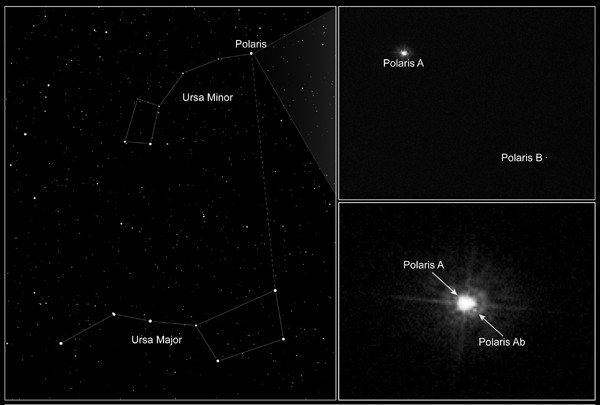
by Jessica Orwig Wednesday, April 25, 2012

This sequence of images taken by the Hubble Space Telescope shows that the North Star, Polaris, is a triple star system. New research also confirms the main North Star is a Cepheid variable. NASA, ESA, N. Evans (Harvard-Smithsonian CfA), and H. Bond (STScI)
The North Star, the Pole Star, the Guiding Star, Polaris: Its many names reflect the many centuries humans have gazed northward to it for guidance. Because Earth’s North Pole is aligned with Polaris’ position in the sky, the star appears motionless, providing a steadfast beacon for early sailors and adventurers alike. But the star itself is far from motionless. In fact, Polaris is a specific type of star known as a Cepheid variable, which pulsates, varying in size and luminosity over a period of days and, according to recent observations, also ejects large amounts of mass into space. Now, combining 170 years worth of observational data on Polaris’ pulsation rates with state-of-the-art stellar evolution models, a team of scientists suggests that Polaris is losing mass at a significant rate. But this does not mean Polaris will vanish from the night sky anytime soon.
When Polaris was first suspected as a variable star in the mid-19th century, its pulsation period was shorter than it is today. Each year, the star’s time between pulses has lengthened by an average of eight seconds, and it’s this change in period that got Hilding Neilson of Argelander Institute for Astronomy at University of Bonn in Germany and his colleagues thinking about the inherent relationship between the rate of period change and mass loss.
“The question is, ‘What drives enhanced mass loss [in Cepheid variables]?’” Neilson says. “There are ideas that the Cepheid pulsation itself will generate waves in the interior and as those waves move outward, they turn into shocks. And those shocks help drive enhanced mass loss.”
Although it is unknown whether this process takes place on Polaris, Neilson and his colleagues have measured the rate of mass loss. Polaris has been the subject of study for many years, so its parameters, such as distance from Earth, stellar radius and temperature, are known to within a small percentage of error, Neilson says.
Neilson and colleagues input these parameters, along with many others, into computer models to predict the rate that Polaris’ pulsation period is changing. When they compared their rates with those from observations over the past 170 years, they found a discrepancy. Basically, the theory disagreed with the observations.
However, when the researchers tweaked Polaris’ rate of mass loss, they found they could fix the discrepancy. If Polaris were ejecting mass equal to approximately the mass of Earth each year, then the predictions of Polaris’ rate of period change closely resembled the observational data, the team reported in the Astrophysical Journal Letters.
Although Neilson and his colleagues attribute the model discrepancy in the rate of period change between observational data and theoretical modeling to mass loss, some scientists say it may not be the only answer.“They get this result that the period change is doing a particular thing and they give one particular explanation, but it’s probably not the only explanation,” says Pauline Barmby, of Western University in Ontario, Canada, who was not involved with the study. For example, Barmby says, another possible explanation — put forth by Richard B. Strothers of the NASA Goddard Institute for Space Studies in a 2009 paper in the Astrophysical Journal — could be that a slow change in the star’s magnetic field is affecting convection and hence periodicity.
Still, even if the debate cannot be rectified, Barmby says, there are several advantages to studying mass loss in Cepheid variables. First, Cepheid variables represent a short phase in certain stars’ lifetimes (lasting about 10 million years) when the star is no longer a main-sequence star like our sun, nor is it a red giant or supergiant — the next evolutionary step initiated by helium burning in a star’s core. During this stage of stellar evolution, stars expand and contract, and the physics behind these pulses is considered to be well understood. So Cepheid variables provide a diagnostic for the structure of stars as they evolve off of the main sequence, which can improve stellar evolution modeling.
Second, knowing their period allows for fairly accurate distance measurements, which are important in cosmology. Measuring the distance to Cepheids in other galaxies is a way for cosmologists to determine how fast the universe is expanding, Neilson says. Therefore, determining the mass loss rate of Cepheid variables is important because it can affect the stars’ luminosity and hence distance calibrations, he adds.
“If you can understand Cepheids better from a theoretical point of view,” Barmby says, “that might help make calibration more solid for using them for finding distance, which would have quite a wide impact on astronomy in general.”
© 2008-2021. All rights reserved. Any copying, redistribution or retransmission of any of the contents of this service without the expressed written permission of the American Geosciences Institute is expressly prohibited. Click here for all copyright requests.